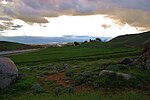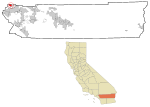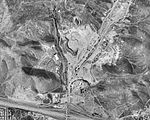Declezville, California
Declezville is a formerly unincorporated community in southwestern San Bernardino County, in the Inland Empire region of southern California. Today, it is located within the city limits of Fontana.The community is named for William Declez, a naturalized U.S. citizen, born in France, well known for his marble business on Los Angeles Street. Declez opened granite quarries in Southern California in the 1860s in the Jurupa Hills on Pyrite Street, and built several Mexican public buildings. He died at age 73 on February 7, 1921, in the Southern Alps. When the Southern Pacific Railroad built a spur to the large granite quarries, it named the junction Declez and the terminal Declezville, after the granite works owner. Declez is now a community within south Fontana.
Excerpt from the Wikipedia article Declezville, California (License: CC BY-SA 3.0, Authors).Declezville, California
Live Oak Avenue, Fontana
Geographical coordinates (GPS) Address Nearby Places Show on map
Geographical coordinates (GPS)
| Latitude | Longitude |
|---|---|
| N 34.044444444444 ° | E -117.48138888889 ° |
Address
Live Oak Avenue 11519
92337 Fontana
California, United States
Open on Google Maps






